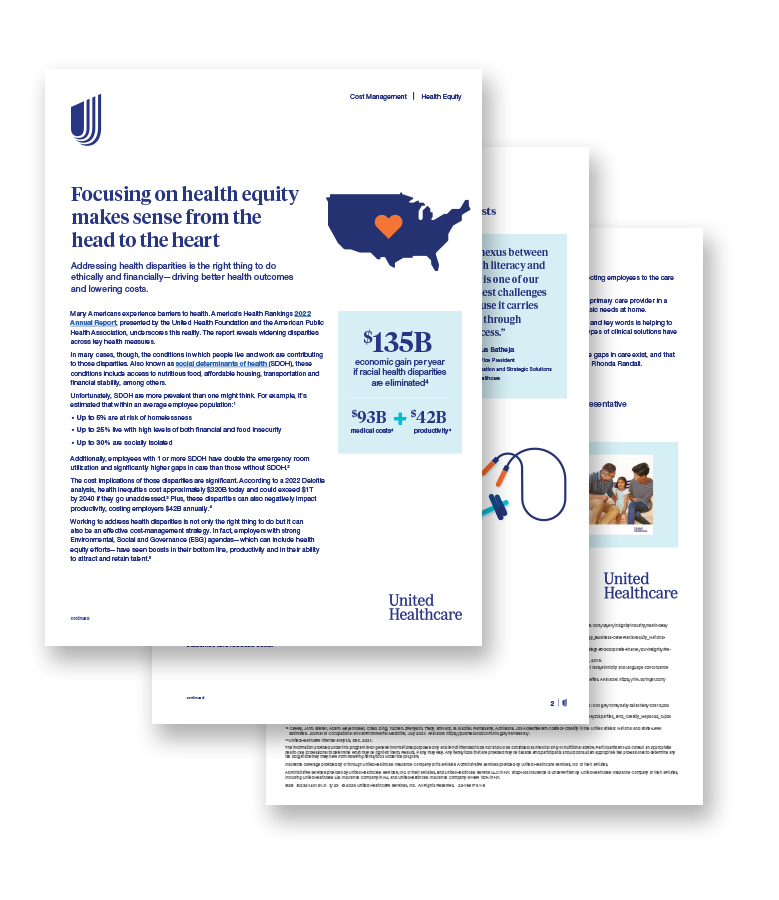Focusing on health equity makes sense from the head to the heart
Addressing health disparities is the right thing to do ethically and financially — driving better health outcomes and lower costs.

Many Americans experience barriers to health. America’s Health Rankings 2022 Annual Report, presented by the United Health Foundation and the American Public Health Association, underscores this reality.
The report reveals widening disparities across key health measures. In many cases, though, the conditions in which people live and work are contributing to those disparities. Also known as social determinants of health (SDOH), these conditions include access to nutritious food, affordable housing, transportation and financial stability, among others. Unfortunately, SDOH are more prevalent than one might think. For example, it’s estimated that within an average employee population:1
- Up to 5% are at risk of homelessness
- Up to 25% live with high levels of both financial and food insecurity
- Up to 30% are socially isolated
Additionally, employees with 1 or more SDOH have double the emergency room utilization and significantly higher gaps in care than those without SDOH.2
The cost implications of those disparities are significant. According to a 2022 Deloitte analysis, health inequities cost approximately $320B today and could exceed $1T by 2040 if they go unaddressed.3 Plus, these disparities can also negatively impact productivity, costing employers $42B annually.4
Working to address health disparities is not only the right thing to do but it can also be an effective cost-management strategy. In fact, employers with strong Environmental, Social and Governance (ESG) agendas — which can include health equity efforts — have seen boosts in their bottom line, productivity and in their ability to attract and retain talent.5
Ways employers can advance health equity — and lower costs
Consider a health plan and network design that meets employees where they are
Some plan designs can unintentionally create or exacerbate health disparities. For instance, plans with higher coinsurance or deductibles can make it more difficult for employees who are experiencing financial instability or other SDOH to afford care, especially during economically challenging times. As a result, employees may defer care altogether, which can result in worse health outcomes and higher costs long-term.
It’s also important for employers to carefully consider how the type of network they select may impact employees. Networks that connect employees to quality providers can benefit the employee’s pocketbook and the employer’s bottom line, but they may not prove effective if the network limits choice.6
"The nexus between health literacy and trust is one of our greatest challenges because it carries right through to access," says Dr. Cyrus Batheja, national vice president of transformation and strategic solutions for UnitedHealthcare.
Think: If an employee lacks access to transportation and there aren’t enough network providers nearby, they may be less likely to seek care or elect to go out-of-network — both of which impact cost.
The same can be said for networks that lack providers equipped to deliver culturally relevant care. Research suggests patients prefer providers who share a similar background as them. In fact, patients with providers who are of the same ethnicity experience better outcomes when it comes to everything from medication adherence7 to patient decision-making.8
Seek out opportunities that engage employees in their own health and well-being
Getting employees with health disparities engaged in their own health is critical to seeing reduced costs and better health outcomes.
Research suggests that healthy behaviors account for as much as 50% of a person’s health status.9 But since all employees don’t come to work with the same understanding about what constitutes healthy behaviors, devoting time and resources aimed at increasing health literacy among a workforce is a worthwhile activity.
Incenting employees to make better health and lifestyle decisions is another good strategy, as 68% of Americans indicate they would be motivated to devote at least an hour per day to improving their health for as little as $2 a day.10
Take weight loss, for instance. It’s estimated that around 40% of Americans are obese,11 with a disproportionate impact among adults with SDOH.12 Obesity also puts individuals at higher risk for more than 250 diseases,12 and the cost to worker productivity is almost as staggering: an estimated $13.4 to 26.8B per year.13 Yet, of those affected individuals, two-thirds are trying to lose weight.11 So, if an employer can implement a personalized weight loss program that encourages healthy behaviors, they may start to see an improvement in health outcomes and reduced costs.
Invest in clinical strategies that work to address health disparities
Investing in smart clinical strategies can also help combat health disparities by supporting and connecting employees to the care they need.
Here’s how: Say there’s an employee who is at risk for certain chronic conditions and hasn’t visited a primary care provider in a while or hasn’t scheduled certain cancer screenings — or perhaps they are struggling to meet their basic needs at home.
Integrating data and insights into provider workflows and training care teams to listen for SDOH cues and key words is helping to identify and close those gaps in care through personalized support and targeted care plans. These types of clinical solutions have led to more proactive intervention and driven upwards of $7.9M in medical cost savings.14
“The data is foundational. When you translate this data and layer in clinical insights, we can see where gaps in care exist, and that informs where we need to innovate moving forward,” says UnitedHealthcare Chief Medical Officer Dr. Rhonda Randall.
Contact your broker, consultant or UnitedHealthcare representative to learn more.
Dive deeper into the topic of health equity
Learn how UnitedHealthcare is advancing health equity by addressing health disparities to improve the health of employees and communities and to reduce costs for employers.